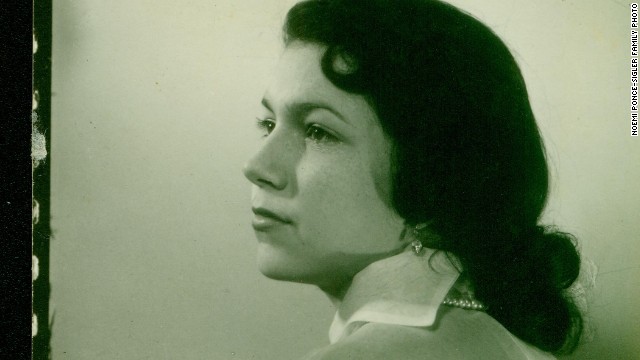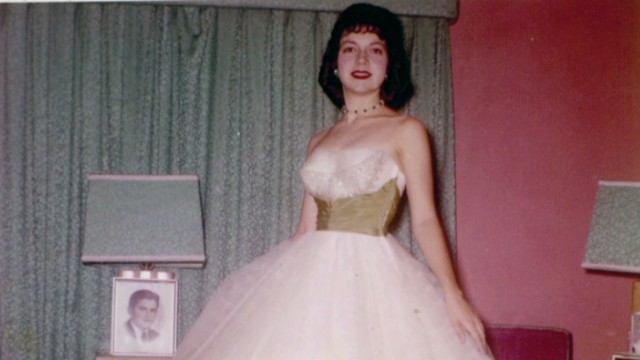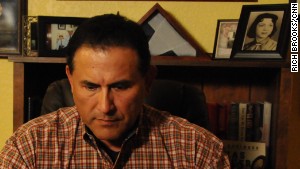Police: Evidence in killing of former beauty queen points to ex-priest
- Authorities believe a Catholic priest killed a former Texas beauty queen in 1960
- John Feit, who left the priesthood in the late '60s, told CNN he did not kill Irene Garza
- A grand jury did not indict Feit
- Garza family says Feit was moved to a monastery as part of a "cover-up"
McAllen, Texas (CNN) -- All evidence pointed police to one conclusion: A priest had killed a beautiful 25-year-old schoolteacher.
Searchers had found the lifeless body of former Miss South Texas, Irene Garza, face down in a canal in her hometown of McAllen. She'd disappeared on the day before Easter after going to Sacred Heart Catholic Church for confession.

An autopsy determined Garza had been raped while in a coma, and then had died from suffocation. Near Garza's body investigators found items that belonged to the church, including a candelabra.
One item, a metallic Kodak slide photo viewer, belonged to a 27-year-old priest who was assigned to the church: the Rev. John Feit.
To say the scandal rocked McAllen is an understatement.
Questioned by police, Feit failed lie detector tests. What was also suspicious was that just 24 days before the killing, Feit had been arrested for attacking another young woman at a church in a town about 10 miles from McAllen. Feit pleaded no contest to misdemeanor aggravated assault. A judge found him guilty and fined him $500 with no prison time.
All this took place in 1960.
Now, more than half a century later, Feit lives in a pleasant neighborhood in Phoenix, after leaving the priesthood in the late '60s. In a sworn statement to authorities and during an interview with CNN, Feit denied he killed Garza. Feit told police Garza left the rectory after he heard her confession and the last time he saw her, she was standing outside the church.
But to this day, police officers and law enforcement agencies that have dealt with the case say they believe Feit killed her.
For folks growing up in McAllen at the time, it was unthinkable that a Catholic priest would commit such a crime. That's the way Garza's cousins remember it.
"We were accusing a priest that -- in those days priests were infallible, " said Lynda De La Vina, who was 9 years old at the time.
Another cousin, Noemi Sigler, was only 10 when Garza was killed. "It was impossible for a priest to do such a deed. I mean, if you thought of it, that would be sacrilegious."
But Feit was the likely suspect, said former Texas Ranger Lt. Rudy Jaramillo, who started investigating the murder in 2002 when he served with a Rangers cold case unit. The evidence, he said, "suggests and indicates that that's who it's pointing to."
Authorities at the time protected Feit, said Sigler. "I don't know whether it was out of respect for the church or anger or fear, I have no idea," she said. Shortly after the killing, the church transferred Feit far away to a monastery. He would be moved to other locations over time, and about three years after the killing, the church transferred Feit to Our Lady of Assumption monastery in Ava, Missouri.
Sheltering Feit "was about protecting the church and somehow believing that the church takes care of their own," said De La Vina. "It was the best that could have happened at that point. Because nothing else was being done."
Sigler describes her view in more succinct terms: It was "a cover-up."
An assistant to the bishop at the Brownsville, Texas, Catholic Church diocese that oversees McAllen told CNN that Garza's death happened so long ago that no one at the diocese has any direct knowledge about it. The assistant said the diocese would always cooperate in every way with the investigation.
For De La Vina and Sigler, the killing opened their young eyes to a world that did not appear to offer equal justice under the law.
Trying to make sense of what seemed like chaos, De La Vina became a "little detective," trying to figure out what really happened by eavesdropping on conversations and looking for clues.
Her father was a local sheriff's deputy and she joined the search during the five days when the town was desperately looking for Garza. "I actually went out with my dad in one of the search parties ... I was so afraid I'd find her."
"He put his whole heart and soul into trying to find her because he really liked the parents, the family," she recalled.
One day Sigler says she realized her beloved cousin wasn't coming back. "Maybe that's why I started off on the journey to find out who killed Irene Garza," she said.
During the next four decades, Sigler made it her mission to knock on doors, interview witnesses and catalog every piece of evidence in the case. The case got colder over the years and eventually faded from the headlines. But the cousins kept pushing until 2002, when the Rangers and Jaramillo reinvigorated the investigation.
Hopes for solving the case were never higher.
Two surprise witnesses had independently come forward -- each separately claiming that they heard Feit confess.
One witness -- a priest named Joseph O'Brien -- worked with Feit at Sacred Heart, where Garza's family worshiped. "We knew he was dangerous, so we shipped him off to a monastery," O'Brien told Sigler during a recorded phone conversation obtained by CNN. "So he told you also, sir, that he had killed her?" asked Sigler. "Yes," O'Brien answered on the recording.
Sigler could only respond, "Oh my God."
When asked if he believed O'Brien was a good, credible witness, McAllen Police Chief Victor Rodriguez responded, "Absolutely." As O'Brien first shared his story with Rodriguez, the chief noticed, "the lifting of a ... heavy burden that he'd carried for a long time," Rodriguez said.
Dale Tacheny, John Feit's ex-spiritual counselor
The other witness to come forward was Dale Tacheny, who had served as a monk and Feit's spiritual counselor at the Missouri monastery where Feit had been sent.
Tacheny told authorities it had taken him 40 years to come forward because the guilt had become too much to keep quiet.
In bits and pieces, Tacheny told authorities -- and also CNN in an exclusive interview -- that Feit told him about a woman whose story sounded very similar to Garza's. According to Tacheny, Feit said he had heard confession from a young woman shortly before Easter. Feit offered to take the woman to the rectory, Tacheny said, where Feit sexually assaulted her, bound and gagged her, fondled her breasts, and put something over her head.
"That's what he did," said Tacheny. The former monk said Feit told him he took Garza to a separate location, where he was living, and hid her there, bound, overnight. The next day Feit needed to return to the church for more confessions.
Tacheny said Feit told him he took Garza, who was bound and wrapped in plastic and "put her in the bathtub ... and as he was leaving, she was saying, 'I can't breathe. I can't breathe.'" Tacheny said. "Then later on that day -- which was Easter Sunday -- he came back and she was dead in the bathtub."
Tacheny said Feit told him he dumped the woman's body near the canal.
He asked Feit why he was living at a monastery and not in prison. "'The church protected me, the people in the church, my superiors, protected me,'" Tacheny quoted Feit as saying.
"I believe he killed her," said Tacheny. "I had no doubt about it because he said he did."
Roadblock
With all this seemingly overwhelming testimony from two independent witnesses, Jaramillo was ready to make an arrest. He said he had even written out the warrant. But first, he wanted a green light from the county district attorney.
But that man, Rene Guerra, has thrown a roadblock in front of the case, said the cousins. Guerra did not bring the case before a grand jury for years, despite the blockbuster testimony from O'Brien and Tacheny. "They're not credible," Guerra said. Worried about winning a conviction, Guerra said he wants a slam-dunk conviction.
Guerra said he's not protecting the church. He questioned O'Brien's state of mind.
In his 70s at the time, O'Brien, Guerra said, was senile. "I didn't trust his mind," Guerra said. "It wasn't that I didn't trust the priest. As far as I know he was a good priest."
Guerra also doubted O'Brien's credibility because he had changed his story. Years earlier O'Brien had lied to police. O'Brien said he had withheld information alleging that Feit committed the killing.
Jaramillo didn't think O'Brien was senile. In fact, he said he thought O'Brien had a "remarkable memory" when he interviewed him in 2002, and agreed with McAllen Police Chief Rodriguez that O'Brien was "very credible."
O'Brien told police he felt bad about lying years earlier.
Guerra also discounted Tacheny's story. He said it wasn't believable because Jaramillo -- the ex-Texas Ranger -- fed Tacheny information that he didn't obtain from Feit.
That's impossible, said George Saidler, who at the time was a San Antonio Police homicide detective. Saidler said Tacheny called him in April 2002 and told him the whole story. That phone call occurred months before Jaramillo says he ever heard of Tacheny. Saidler, now deputy chief of criminal investigations for Bexar County Sheriff's Department, said he believed Tacheny's story. "I was convinced," he said.
Eventually, in 2004, a grand jury did hear the case. But in a shock to the Garza family, Feit wasn't called to testify. Neither were the new witnesses, Tacheny and O'Brien.
However, jurors did receive transcripts of Tacheny and O'Brien's version of events.
A year later, O'Brien, age 77, died. The grand jury voted not to indict Feit. The Garza family was crushed.
'I promised her'
Now, years later, Jaramillo, Sigler and De la Vina have had time to assess their battle to have Feit charged.
"I wish we'd won," Jaramillo said thoughtfully. "I made it my goal to try to solve this case," said Jaramillo. "I wanted justice for her."
De La Vina isn't giving up. She said she still believes one day Feit will face murder charges.
For Sigler, after it was clear the grand jury was not going to indict Feit, she acknowledged, "We started losing belief in the justice system."
That led to a trip Sigler made to the cemetery where Garza is buried. After researching and pushing the case for nearly two decades, she was ready to call it quits. Standing at Garza's grave site and feeling her presence, it hurt, Sigler remembered, because, "I promised her I'd never leave her. I'd never leave her behind."
Suddenly a beautiful white dove landed nearby and looked straight at her. Sigler was certain the bird was a sign from the beautiful, young schoolteacher whose life had been cut short. "So I told Irene, 'OK, Irene I got the message ... I'll keep on.'"
http://edition.cnn.com/2013/05/31/justice/garza-texas-priest-murder-case
'연예계와 일루미나티의 연관성' 카테고리의 다른 글
| 23 movies with a message of truth and consciousness (0) | 2013.06.14 |
|---|---|
| Symbolic Pics of the Month (06/13) (0) | 2013.06.13 |
| Steven Seagal: International man of mystery (0) | 2013.06.08 |
| The Hidden Life of Marilyn Monroe, the Original Hollywood Mind Control Slave (Part-II) (0) | 2013.06.06 |
| Why Walt Disney is trying to Corrupt our Children ??? (0) | 2013.06.01 |






